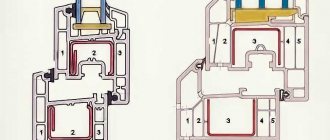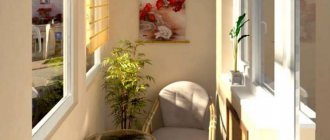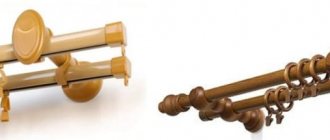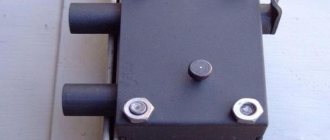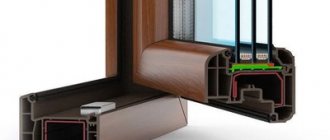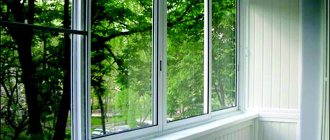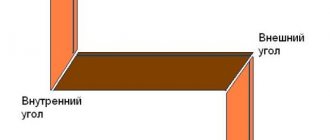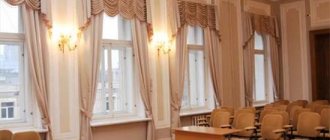Tell
The choice of curtain rod can affect not only the perception of the interior of the room, but also its size: a well-chosen cornice can visually “raise” the ceiling, “expand” a too narrow wall, and add volume to a small room.
Curtains should always match the chosen interior style, match the color scheme and complement the overall picture. They play an important role in the decor of the room, but cornices are no less important. In addition to the fact that the cornice has a constructive task - to hold the curtains, ensure their reliable operation, easy closing and opening, it must also stylistically match and fit harmoniously into the interior.
In order to choose the right curtain rod, you need to consider the following factors:
- Each curtain rod is designed for certain loads, so roughly estimate the weight of the curtains and select the curtain rods in such a way that they correspond to this indicator.
- Decide on curtain mounts. They must match the chosen fabric, move along the cornice easily, without clinging or getting stuck, and there should be no sounds.
- For light curtains, any type of curtain rod fastening is suitable, both ceiling and wall. For heavy materials, it is better to prefer a ceiling mount - it can withstand more weight.
- The choice of cornice is influenced by the location of the radiator, heating pipes, as well as the size and width of the window sill. Nothing should interfere with the free hanging of the curtains, so when attaching the curtain rod you will have to take these elements into account.
Advice. Remember that a correctly selected cornice can visually change the perception of a room, correct shortcomings and highlight advantages:
- Narrow window. If the window has a small width, you can “enlarge” it - to do this, select a long cornice so that the curtains hanging on it cover not only the window, but also part of the wall near it.
- Low ceilings. The ceiling can be visually “raised” if you choose a cornice with a ceiling mount: a curtain hanging from the ceiling to the floor will help “lengthen” the distance between them.
- The window is too big. To correct the perception of the window, select a cornice that is exactly the width of the window opening.
Cornice and room style
From the many options for curtain rods on the market, choose the ones that best suit the style of your interior.
- For decorating rooms in a classic style, we offer baguette cornices. Round cornices also look good, especially if they are wooden.
- Minimalism or hi-tech that is popular today can be complemented with a string cornice or round metal cornices.
- Almost all “rustic” styles, be it American country or French Provence, use forged products as decorative elements. Forged cornices are suitable for them - both in natural metal color and painted.
- Japanese and Roman blinds go well with aluminum profile curtain rods.
Cornice length
The total length of the cornice includes the length of the crossbar and two decorative finials. But before you start measuring the length of the curtain rod, you need to determine where it will be located and how it will be attached.
- When choosing a cornice for curtains that cover the entire wall with the entire window, the length of the cornice itself should be two to three centimeters less than the distance from the wall to the wall. Please note that there must be at least three attachment points for such a long cornice!
- If the cornice is located exactly above the window, then the brackets on which it is attached must be behind the window opening, otherwise you will not be able to open the window completely, and the drawn curtains will cover part of the glazing. In this case, the length of the cornice should be thirty to forty centimeters greater than the width of the window opening.
Brackets
Please note that the brackets have different lengths. If this length is greater than the distance from the window opening to the ceiling, the bracket will not fit above the window. Sometimes in such cases they are mounted below the level of the window opening; this placement is called “partially above the window.” If the cornice is more than two meters long, then it must be mounted on three brackets; if less, two are enough.
The distance between the brackets should ideally be no less than one and a half and more than two meters. In this case, the cornice will hold tightly, its rods will not be deformed, and the curtain fabric will not sag.
Cornice dimensions
To choose the right curtain rod, its design and position, you need to take the following measurements (in cm):
- The length of the wall with the window from one side wall to the other.
- The width of the window itself.
- The distance at which the curtains will be separated from the wall.
- Height from window opening to ceiling.
Types of fastenings
Each type of window curtain rods has its own fastenings for hanging curtains. Let's look at the most common options.
Profile systems
The aluminum profile has guides, one or more, along which the hooks slide—the curtains cling to them.
Pros. Aluminum is quite strong, but at the same time flexible; round-shaped cornices can be made from it to decorate niches, bay windows, lancet or other non-standard windows. In addition, it is profile curtain rods that are usually equipped with automatic curtain position control systems, which is very convenient, especially if the room has high ceilings.
There are also profile systems made of plastic, which are attractive due to their low price. They are suitable only for light fabrics, since heavy curtains with their weight cause their deformation.
Hooks for profile systems are made of transparent plastic - so they are less noticeable. Planks “like wood,” “like stone,” and “like leather” are usually attached to the top of the system for decorative purposes. Installation and installation of such structures are simple and do not require much time.
If you need multi-row options for curtain rods, profile ones are the best choice. They can consist of curtains in two, three, or even four rows. For example, on the profile closest to the window, transparent tulle is attached, the next one carries a thick curtain, and the outermost one carries a lambrequin. Or you can attach transparent tulle of different colors to all rows, which will make it possible to vary the density of the light flux and its shade according to your mood.
Roller blinds, Japanese curtains, Roman curtains and blinds, which are popular today, belong specifically to profile systems and have a common basis, although there are design differences between them.
Classic cornice
The most traditional type of window cornice is tubular structures. They can be made of wood or metal pipe. The larger the diameter of the cornice, the heavier the curtains it can withstand.
Fastenings for such curtains can be as follows:
- Magnetic clips that serve not only as fasteners, but also as decoration. Can be of various shapes and colors.
- Fabric loops.
- Eyelets (holes in fabric edged with metal or plastic).
- Rings made of wood or metal to which curtains are attached using hooks. Tulle and organza can tear on the fasteners, and it will not hold dense fabrics; this option is only suitable for medium-density fabrics.
When choosing eyelets or rings as a fastening when choosing a curtain rod, check the diameter of the cornice - it should be smaller than the diameter of the fastening ring, otherwise the curtain will not slide along the guide.
Typically, classic curtain rods have one or two tubular structures - you can hang tulle and thick curtains on them. It is also possible to replace one of the structures with a string - the most suitable fastening for tulle and borders. Classic cornices are suitable for any interior; it is only important to choose the right material from which they are made.
Forged cornices
If you want to choose a curtain rod that will decorate a room in Baroque, Rococo, Empire, Country or Provence styles, pay attention to forged products. Depending on what tips they end with and what fabrics are used for curtains, such curtain rods look completely different.
Graceful empire curls and velvet or satin curtains will create an atmosphere of luxury in the Baroque style, and forged floral elements and “chintz” curtains with small flowers will transport you to the sultry summer of Provence.
The brackets of forged cornices themselves are interior decorations. The ideal option is to order them individually to best express your personal preferences and create a unique look for your home. Forged cornices use metal pipes or rods as guides, and in this they are similar to classic ones. There can also be several guides, usually no more than three.
String cornices
String cornices use a stretched metal wire - a “string” - as guides. Curtain fastenings are the same as in a classic cornice, but smaller in size. Magnetic clips look best on this design. Plastic strings are also used - they are suitable for light curtains made of tulle or organza. Such a cornice is practically invisible and there is a feeling that the tulle is floating in the air without any support.
Of all the options for curtain rods, this option is the most “lightweight” - it will not hold heavy curtains. More than others, it is suitable for decorating rooms in high-tech, minimalism, modern, and combined styles. Such cornices, with the correct selection of accompanying elements, are most suitable for masking the shortcomings of a room.
Baguette cornices
Baguette cornices are similar in design to profile cornices, but the fastenings in them are always covered with a decorative strip - a baguette. The baguette can be wide or narrow, of various shapes, sizes, colors.
Curtain profiles can have from one to three rows. In the first row, a Velcro strip is often placed to secure the lambrequin. When choosing a baguette cornice, focus on the color and shape of the baguette itself - after all, it is the main decorative element and should fit organically into your interior.
Let's say you purchased newfangled curtains that completely fit into the interior style of your home. Now is the time to also influence the perception of the room. By choosing the right accessory for curtains, you can change the image of the room - narrow it or, conversely, expand it, and also slightly increase its height.
Decorative cornice for curtains on windows
If the curtains are made of heavy, thick textiles, you need to take into account the weight of the fabric and purchase a curtain rod that can withstand a heavy load. How to choose a curtain rod for almost weightless curtains? A bulky product will look too strict and pretentious - the cornice should complement the curtain and not come to the fore.
How to choose a cornice among the many presented in specialty stores? To begin with, it’s a good idea to familiarize yourself with all its types and understand how they differ from each other.
Classification of cornices
Profile products
They are made of metal, equipped with plastic fittings, lightweight, bend in accordance with the radius of curvature of the wall structure, ideal for installation on complicated devices and arched window openings. They can have either one stripe or two at once. Such models are fixed to the wall with fasteners and fit perfectly to secure a light curtain.
Profile curtain rod
It varies from 10 cm to 30 cm in length, which makes it possible to install with the required overhang. Therefore, even if the window sill protrudes noticeably beyond the general boundaries of the window, curtains with such a cornice will not “lay” on top of it.
Experienced craftsmen note the versatility of profile samples, which can be mounted not only in residential premises, in the office, but even on theater stages on stage. It’s very convenient that the products are equipped with a device for drawing curtains - now you don’t have to touch them with your hands and worry that they will get dirty ahead of time. The mechanism provides for raising French, Roman and Austrian types of curtains, and everything works automatically, without hesitation or breakdowns.
You will have to tinker with cornices that are fixed at corner turns to the wall - they are made to order according to measurements provided by the customer. Correctly taken measurements allow you to avoid the gap that usually forms between the curtains and the wall.
Plastic products
Thanks to the presence of internal filler, they can withstand heavy curtains. They are considered the simplest and most convenient device, which can be attached to the ceiling if desired.
Plastic curtain rod
If the interior has classic notes, such models are provided with a decorative overlay that imitates wood.
Metal specimens
Conveys multiple metallic shades - gold, bronze, silver, retro metals. In addition to being durable, they pair wonderfully with unusual themed curtains secured with rings that can be replaced with ties and loops.
Metal curtain rods
You should not count on the cheapness of this product - high-quality metal products are expensive.
Forged cornices
A true work of art, such models are hard to find on sale. Forging adds chic and luxury, but it shows capriciousness and pretentiousness in relation to furniture and renovation of an apartment or house. Especially notable are the forged tips, made in the form of arrows or pipes.
Wrought iron curtain rod
You can “manage” the curtains using a pointer handle and a cord - the first device adjusts the position of the curtains to the left or right, the latter raises and lowers them. Products with an electric drive are equipped with a remote control. As you can see, everything was created solely for the convenience and comfort of the consumer.
Round samples
Buyers prefer round two-row and three-row curtain rods, with a pipe - such models are multifunctional and make it possible to design the curtains as your heart desires.
Pipes are made from metal, wood or metal-plastic, each of which has a number of advantages. The classic, the wooden version, still remains popular.
String products
As you might have guessed, in such devices pipes are replaced by elegant and laconic steel strings running from one bracket of one wall to the opposite one.
String curtain rod
You shouldn’t count on the string to support a heavy thick curtain - you can only attach tulle to it.
Baguette cornices
Here all the details are decorated in a strip that plays a decorative role. You can choose a shaped strip, embossed, with a pattern or design.
Baguette curtain rods
Can have 2 or 3 rows. When purchasing such a model, pay attention to the matching color of the strip with the wallpaper and curtains - too saturated or, conversely, faded shades can spoil the appearance of the adjacent wall and ceiling.
Wooden cornices
Their cost varies markedly due to differences in the quality of the types of wood from which the products are made. The wooden material is represented by oak, pine, cherry, walnut, and can be pressed into a flat shape or be a round stick-pole with rings strung on it.
Choosing such a model for parquet floors and ceilings is as easy as shelling pears - natural colors fit into any design style.
How is molding different from cornice?
Molding
- an element of interior decor that has a straight back side and is designed to be attached to one plane. They are used to frame mirrors, windows, doors, highlight arches, panels on walls, etc. Moldings are used at the junctions of different finishing materials, for example, when the lower part of the walls has one finish, and the upper part another. Moldings can create luxurious accents by zoning or highlighting decorative elements. On the outside, they can have a variety of ornaments, patterns, or be made in a restrained, simple style.
Cornice
on the back side it has two planes and is designed for mounting in a corner, between the wall and the ceiling. The design of cornices can also be very diverse.
Questions for designers
Criteria for choosing a cornice for the style of the room
Experienced designers shared their own secrets and recommendations on how to choose the right cornice:
- A spacious room, not cramped in space, and also made in a classic style, will benefit from baguette and round cornices.
- High-tech does not tolerate banalities, so string products will come in handy here.
- Aluminum profiles add sophistication and sophistication to Japanese and Roman curtains.
- If the apartment or house is decorated with natural materials, for example, wood or stone, do not skimp and buy forged products.
How to adjust a room using a cornice?
Despite the fact that the cornice is an auxiliary and functional element, it is able to level out and hide the shortcomings of the room:
The role of tips and decorative details
For some reason, the concept has taken root in our society that it is better to hide the cornice than to show it off, even if it is worth it. However, designers continue to change the minds of customers by decorating rooms with profiles. Unusual accessories and decorative details are good helpers in a successful frame.
Brackets, holders, eyelets and other fasteners can serve as decorative parts; tips are also indispensable. They can be sold as a set or selected separately.
Curtain brackets
Finishes made of crystal and Murano glass will help draw attention to a beautiful curtain; they look especially unusual in the shape of a cone and a ball. In a children's room it is appropriate to place tips that imitate fruits, greens and animals.
Don't forget about the rings - the best today are products with Teflon coating, which ensures silent and smooth movement of fasteners along the baguette.
How to position the cornice
Before you buy a cornice, you need to calculate what length of the product will suit you. To do this, you need to decide how the device will be placed:
- From wall to opposite wall.
Measure the distance between the walls using a construction tape. Now add 2-3 cm - this will be the final size of the cornice.
- Above the window opening.
In this case, the guideline is the width of the window, to which at least 30–40 cm is added.
- Partially above the window opening.
You will need to measure the distance between the walls, the width of the window, the minimum protrusion from the wall structure to the curtain, the segment between the ceiling surface and the back side of the window opening.
Accessories
An important component of any cornice are its components. Their choice is very important
The main element here can be called a bracket or, as it is also called, a holder. It is mounted to the wall surface and supports the weight of the entire structure. It can become a wonderful decorative element if executed appropriately. Naturally, the bracket should be made of the same material as the rest of the cornice. You should also understand that depending on the weight of the curtains, you need to take into account the type of fastening. This is a very important point, because no one wants the entire mechanism to fall due to a loose connection.
There are several types of brackets. For example, they are divided according to the place of attachment. There are holders above the window, ceiling and wall to wall. Based on the name, you can understand their difference. You can also divide them into open and closed types. The closed one is more reliable, but it poses more difficulties when removing the cornice.
It is also worth paying attention to the fasteners. Hooks, rings, sliders, clips - all these variations are widespread now
In accordance with the model of the cornice, fasteners are also selected, which should fit harmoniously into the overall picture. Even if this is a small element, if chosen incorrectly, it can disrupt the overall concept and will stand out against the general background. It must also be of high quality and reliable in order to hold the curtains for a long time without any problems.
Selecting cornice parameters
The length of the cornice includes the length of the crossbar and two ends. Before choosing the length, first decide on the location of the cornice. With the “wall to wall” option, choose the length of the cornice 2-3 centimeters less than the distance from wall to wall. Install the cornice on at least 3 brackets.
In the “above the window” option, install the brackets behind the edges of the window opening so that you can move the curtains and open the window completely. In this case, the total length of the cornice should be taken 30 - 40 centimeters wider than the window opening.
Please note that in both cases the distance from the extreme point of the window to the ceiling must be sufficient to install the brackets. If this distance is small, then the bracket will not fit there. In this case, the option “partially above the window” is suitable, when the brackets are placed slightly below the window level, along the edges of it.
When choosing, remember the presence of batteries, pipes, and the width of the window sill. After all, curtains should hang freely from the curtain rod. To do this, there must be an optimal distance from the eaves rod to the wall.
Now about how many brackets to buy. If the length of the cornice is up to 2 meters, then you can get by with two brackets. The optimal distance between brackets is 1.5 - 2 meters. Then they securely hold the curtain rod, and the rods themselves do not sag under the weight of the curtains.
- The distance between the side walls at the window.
- Window width.
- Minimum distance from the wall to the curtains.
- Distance from the ceiling to the top edge of the window opening.
- Take this cheat sheet and go to the store.
- When choosing a cornice, remember that it must match the interior.
- For a room in a classic style, a baguette cornice is suitable. You can also use a round cornice, especially a wooden model.
- If the room design is minimalist or high-tech, buy a string cornice.
- Aluminum profiles go well with Roman or Japanese blinds.
- In a room decorated with stone or natural wood, it is better to use a forged cornice; it is ideal for high style.
- If the room is low, buy a ceiling cornice, then it will appear higher.
- To visually enlarge the window, choose a long cornice. If the curtains cover part of the wall, the window will appear larger than it actually is.
- For curtains with a lambrequin, it is optimal to fix the cornice under the ceiling so that it does not cover part of the window. You need to take a triple cornice.
- For a children's room, the ideal option is plastic curtain rods, as they come in all colors and blend seamlessly with bright furniture for kids.
The color of the cornice plays a huge role in shaping the proportions of the room. The choice is influenced by the palette of walls, interior style, ceiling height, color of curtains, size and geometry of the opening, dimensions and shape of the window that needs to be decorated.
Practical advice
1. Remember that the total length of the cornice is calculated along with the decorative tips. The optimal distance from the tip to the side wall is 2 cm.
2. For a cornice up to 150 cm long, 2 brackets are required, 3 fastenings for a cornice 150–280 cm and 4 for a length from 280 to 385 cm. This rule must be observed to ensure the reliability of the structure. To allow you to safely open the curtains, install the brackets slightly outside the window frame.
3. Before choosing a cornice, estimate the distance from the window frame to the ceiling. If it is too small, some brackets may not fit. In this case, use the ceiling mounting method.
4. If you are thinking about how to choose a cornice for a stretch ceiling, then it is better to start with the fastening. In this case, the best option is wall cornices. Models from IKEA can be secured in any way. For example, the REKKA cornice has universal fastenings. Another option for a curtain rod for a suspended ceiling is the VIDGA curtain system. It will be enough to purchase it together with wall mounts.
5. When choosing a cornice, pay attention to pipes and radiators. A curtain rail with corner joints will help hide the side risers. This tire is also perfect for bay windows.
How to choose
Today, the range of cornices is represented by a huge palette; you can choose not only the color, but also the shades. Here the main question is: what is the guideline? In each individual case, the answer is different, and not even the most experienced designer will give clear recommendations. There are only a few general tips that will help in choosing the color of curtain rods.
Under the walls
Selecting the color of the cornice to match the main tone of the wallpaper or wall paint is a universal solution. The option is neutral, suitable for rooms of any size, merges with the main color of the finish, “gets lost” in the interior. The composition turns out to be holistic, and the main aesthetic load falls on the curtains.
The color of the curtains
Cornices are relevant in rooms with low ceilings. This combination visually raises the opening vertically, as a result the proportions visually change. This same solution helps when the interior is overcrowded with details and you need to calm down the riot of decor a little.
Contrast with the main finish
If the room is high, then cornices in contrast with the main decoration will be perfect. Prem is very effective if the colors are polar, for example:
- White black;
- cream, light beige/dark chocolate, wenge, walnut, cherry in rich colors with a red tint - this combination can be called classic;
- black, dark brown, burgundy, purple, rich red, green walls/metallic color of curtains - silver, gold, brass, light gray; fastenings for curtains in natural wooden shades - honey, amber - work well here.
Curtains, in contrast with the decoration, horizontally cut the space and align the geometry. Designers also often use this technique if they need to decorate a very long opening with several windows. Here the curtains are matched to the color of the curtains, and this composition visually breaks up the elongated wall, eliminating the feeling of being stretched out.
To the ceiling
– a win-win option in any interior. The choice here is small - all shades of white, or a selection of shades to match the color of the stretch fabric. The cornices become invisible, blend into the overall design and do not draw attention away from other details.
Recipes for a positive interior
Professional designers cannot give an unambiguous answer to the question of how to choose the color of the cornice. In each case everything is individual. However, there are some general tips that are worth using.
For example, for a living room or bedroom you should not choose very bright cornices. Even if the curtains, furniture or decoration are made in colorful colors, it is better to choose a neutral curtain rod. If you are choosing a cornice for a child's room, bright colors are quite acceptable. There are even special cornices for children's rooms; they are not only of different colors, but also have fancy shapes, for example, in the form of a tree branch. Such cornices will harmoniously complement the interior of a children's room and your baby will like it.
Furniture, skirting boards, parts and accessories
Textures and textures also play a huge role in choosing the color of the cornice. If the handles on the doors and the chandelier are made of bronze, then the curtain mount should be chosen in this segment. Metallic gloss, such as chrome products, and the discreet shine of brushed metal, are recommended to be combined with gray shades in the design of the space. For gold accessories, it is better to choose a cornice in the same palette.
If furniture made of chipboard or wood, as well as baseboards and trim on doors, are made in a dark color, then the curtain rod should be in this color segment, and vice versa, this way you will avoid dissonance in the design. In modern styles (high-tech, techno), furniture made of glossy materials is often used for furnishings; cornices with metallic shades will look good here: shining polished stainless steel, gold, silver. Cornices in the color of bronze, brass, and aged gold are ideal for furnishings made of natural wood, especially in classic interiors.
When choosing between metallic and wood shades, it is recommended to look at the overall interior design. Sometimes a bright, shiny note needs to be added to a calm brown palette. And vice versa, if the room is already filled with details of metallic shades, then it is better, if not muted, then at least not to add shine.
Materials
Ceiling cornices are made from different materials. This indicator directly affects the cost of the product and its performance characteristics.
Plastic
The lightest and most inexpensive are plastic structures. This common material is extremely easy to process, so today you can find cornices in a wide variety of designs on sale. With the help of such elements you can create a very interesting and stylish interior of any room.
The most inexpensive are white plastic structures. They are ideal for decorating standard PVC windows, so they look organic in residential and industrial premises. Plastic cornices decorated with various strips look especially attractive. They can be a luxurious imitation of stucco, as well as gold or silver decor. Such designs often contain graceful rounded edges and neat joining details designed to hide the connection of the various elements of the curtain.
Today in stores you can find very convenient and practical plastic curtain rods, which contain special Velcro on the strips necessary for attaching lambrequins.
Iron
Iron cornices are recognized as the strongest and most durable. They can withstand heavy loads and can be used to hang luxurious multi-layer curtains arranged in intricate compositions, as well as tapestry or curtain fabrics.
Nowadays, there are many clever technologies that can be used to implement a variety of design trends in metal. The most common fastenings today are those made in modern styles: high-tech, modern, loft, minimalism. However, if desired, it is also possible to find an elegant curtain with ornate lines and patterned inserts, made in a classic manner.
Aluminum
It is worth highlighting aluminum cornices. This material is highly durable and does not corrode. Its main advantage is its light weight, which allows the use of aluminum cornices for installation on plasterboard ceilings. Many consumers choose such parts because they are easy to process. They can be repainted at any time in the color you like.
Also, aluminum curtains can be laminated with a beautiful film. Models with coatings imitating gold, natural wood with its natural patterns, bronze, rich champagne or stone structure look very impressive and elegant.
Wooden
Natural wood cornices are perfect for any curtains and drapes. The main advantage of this material is its environmental friendliness, beautiful appearance and performance properties.
Modern wooden curtains are made in different styles. It can be not only exquisite classics, but also light rustic country, laconic minimalism, luxurious baroque, etc.
Products with carved patterns and intricate relief weaves on their surfaces look expensive and attractive.
Currently, beautiful and durable natural wood cornices are available in a variety of colors. For example, models made of hard bleached oak have the lightest tones, while walnut cornices have soft colors with honey tones.
When looking for dark curtains, it is recommended to pay attention to chic models made of natural wenge wood
It is recommended to select a wooden cornice in accordance with the shade of the baseboards and furniture in the room. Natural designs painted in bright and positive colors are ideal for children's bedrooms. This can be an original cornice of yellow, green, orange or coral color.
Wood structures are suitable for all types of curtains. They are able to withstand heavy loads. For lighter and airier curtains, it is better to buy thin and elegant curtain rods with single-row or double-row fastenings. For heavy and thick curtains, it is recommended to select denser and more durable multi-row curtain rods.
It is recommended to treat wooden structures with special impregnations so that they do not crack, dry out, and wood parasites do not settle in them. It is not recommended to attach such curtains to a plasterboard ceiling, as they are heavy and can damage such a light finishing material.
Cornices made from natural wood are expensive, especially if they contain carved and openwork elements.
Color, functionality and interior style
Today you can buy curtain rods in absolutely any color; the larger segment is represented by natural and neutral shades; models in a bright, rich palette are less common. And here the buyer faces a difficult choice.
Functional
Logically, it is better to purchase a cornice of a regular color for a standard interior, but bright accessories excite the imagination and you want to add something original and accent. In such situations, you should be guided by the functionality of the room for which you are choosing a cornice.
In the bedroom, office, or living room, it is recommended to choose curtain mounts in a calm, natural color. Bright models are suitable for decorating the kitchen and nursery; here you should rely on your taste and the right combination of colors. So, if the room is made in a green/yellow palette, you should choose shades of this segment, but a blue cornice is unlikely to fit harmoniously into such an interior.
Bright cornices are a decoration for the room; it is important to choose the right tone, type of fastening, and model design
Interior style
Usually, in interior design there is some basic style: classic, oriental, ethno, eco, modern, modern, etc., which dictates its color segment for decoration.
For example, classic styles are characterized by white, beige, brown, natural wood, gold, natural shades of yellow, green and blue, respectively, and curtain rods should be in this color segment. For a loft, the basic colors are gray and white, which means curtain mounts in metallic shades will be relevant here. Minimalism - beige of different tones in contrast with dark chocolate, wenge, so you should give preference to wooden rods or baguette models with a simple decorative insert without frills. For country and eco styles - warm wooden shades: honey, walnut, straw, amber. High tech is based on pure, rich colors: black, red, gray, which means that the cornices should be the same color as the main finish or have a metallic gloss.
If you really need curtains, you can buy models that are not noticeable in the interior, for example, fastenings with a strip for a lambrequin. They are a lifesaver, but a special niche should be made for their installation during the repair process. A good option is wooden and metal rods with simple brackets and discreet tips. They become almost invisible in the interior, if they are like a lambrequin skirt.
It's hard to imagine a window without beautiful curtains. This means that it’s time to look for a suitable fabric and find out how to choose the right cornice, because it’s so difficult to get lost among all the assortment presented in stores.
How to choose a curtain rod: photos inspire
There is a saying among designers and not only that windows are the eyes of a room, which means that they should be framed in a worthy manner. But before choosing curtain rods, photos of which you can find in the catalogs of manufacturers, it is important to decide in what style the window opening will be decorated. Cornices can be one-, two-, or three-row, and are made of materials such as:
- tree;
- metal;
- plastic.
Wooden construction is already a classic of the genre, fitting perfectly into any interior. To make such a product, wood with a dense texture and clearly defined fibers is taken. Usually preference is given to:
- nut;
- oak;
- cherry;
- and some coniferous species.
Wooden cornices are rarely three-row and do not include a tulle-curtain-lambrequin combination.
Plastic is a more economical and versatile material that perfectly adapts to any style and is available in a wide range of shades and configurations. The disadvantage of such products is that low-quality plastic can fade or crack over time.
Metal cornices are distinguished not only by their durability, but also by their solid appearance. They go well with various fabrics and can be an interesting accessory in themselves, and forging elements give such products a special chic. Cornices are available in glossy or matte, and are also made of copper, brass or other materials. Black, white, gold or “silver-plated” products are very popular.
Pilasters and columns
Includes several parts. The trunks are decorated with grooves to give elegance to the elements. Stucco columns are created in various styles. As a rule, columns made of polyurethane are intended exclusively for the successful design of walls and do not carry any load.
However, if necessary, hollow elements can be equipped as load-bearing elements. For these purposes, a metal stand is placed in the cavity of such a column, which will bear the load.
In such cases, columns made of gypsum must be reinforced. Columns made of stucco often hide various risers located along the walls in the apartment in a visible place.
Which cornice is better: the perfect choice
In the question of which cornice is better, you should start not only from the material, but also from the design. According to the configuration they are distinguished:
- rod;
- strings;
- rail;
- profile;
- baguette
The main thing is that the product matches the mood and style of the interior. When choosing a cornice, it is important to consider a number of factors:
- distance between walls;
- window width;
- the height of the wall section between the ceiling and the window opening.
The question of how to choose the length of the cornice often confuses buyers. Usually this parameter is determined as follows: window width plus 40-50 cm. Such calculations are valid for small and medium-sized rooms. When decorating windows in large and elongated rooms, the rods are stretched along the entire wall with indentations along the edges of 3-4 inches. A larger length requires a larger cross-section of cornice pipes and strips, and in order to avoid sagging of the structure, one additional bracket is added for every one and a half meters of length.
According to placement on the wall, the cornices are arranged in the following ways:
- from corner to corner;
- just above the window;
- partially above the window.
One method or another can significantly adjust the spatial geometry of the room. The appearance of the entire room depends on the choice of cornice.
How to choose ceiling cornices
Based on the method of fastening, cornices are divided into wall and ceiling; the latter are more advantageous because they go well with many styles and allow you to visually make the ceilings higher. So, how to choose ceiling cornices correctly, what parameters to pay attention to?
- The cornice can be made of plastic or lightweight aluminum, which is more durable and has good performance characteristics.
- Decorative consoles on the products serve as an additional decorative element and give the window a more elegant look.
- Number of rows of canvases.
- Type of clips and hooks: plastic ones are quieter when moving, while metal ones are more effective.
Curtain rods with the type of ceiling mounting have another significant advantage - good thermal insulation properties, ensured by a tighter fit of the curtains to the wall, which creates a kind of barrier to cold air from the window.
The financial side of the issue is also important, but today cornices are presented in such a variety that choosing the optimal model in all respects is not difficult.
What material are the curtain rods in your house made of? Tell us about it in
Size
If you're choosing curtain rods for your home or apartment, make sure you read our tutorial on how long they should be. Too many people make the wrong choices and it ruins the final effect of their window treatments.
Also, in my opinion, thinner curtain rods look better than thick ones, so I always choose curtain rods that are about an inch in diameter. However, you shouldn't choose anything thinner than 2.5cm, as they tend to look cheap, like you bought them from IKEA. There's nothing wrong with buying curtain rods from IKEA, just get them at least 2.5cm thick.
The curtain rods in the photo below would look much better if they were closer to an inch in diameter, and even better if they were black to coordinate well with the legs of the bedside ottomans and picture frames.

